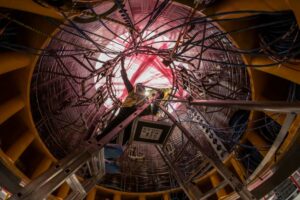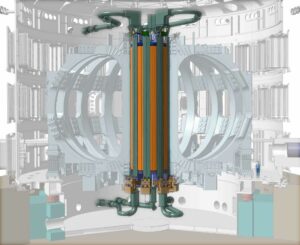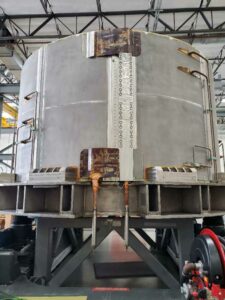In a critical fusion breakthrough, scientists from the international ITER nuclear fusion energy project have announced the completion of the sixth and final component of the reactor’s central solenoid, a magnet powerful enough to levitate an aircraft carrier.
Described as a “landmark achievement” by the 30-country ITER collaboration, the pulsed superconducting electromagnet and other completed components will be assembled at the group’s designated site in southern France.
“By integrating all the systems needed for fusion at industrial scale, ITER is serving as a massive, complex research laboratory for its 30-plus member countries, providing the knowledge and data needed to optimize commercial fusion power,” the group explained in a statement announcing the achievement.
Considered the ultimate source of energy and based on the fusion reaction at the heart of the sun, nuclear fusion could revolutionize power generation by offering a safe, abundant, carbon-free way to satisfy the world’s growing energy needs. It could also revolutionize spaceflight by creating nuclear-fusion-powered spacecraft that can traverse the solar system.
 An ITER team member works inside the Central Module. Image credit: ITER.
An ITER team member works inside the Central Module. Image credit: ITER.
Why Does Nuclear Fusion Need a Magnet Powerful Enough to Levitate an Aircraft Carrier?
Scientists need to create and maintain a superhot, volatile plasma core to achieve a fusion reaction that generates more energy than it uses. However, the temperatures the ITER reactor hopes to reach are so hot they would tear through any material container. As a result, scientists have turned to magnetic fields that can suspend the ball of plasma without coming into physical contact.
According to the ITER team’s statement, their core of ionized hydrogen gas made from deuterium and tritium gas will ultimately reach 150 million degrees Celsius, which is “ten times hotter than the sun’s core.” Atomic nuclei that reach this temperature begin to combine or “fuse,” resulting in a massive release of energy. Scientists call this a fusion reaction.
 A rendering of the ITER Tokamak’s central solenoid that will use powerful magnets to confine superheated “burning” plasma. Image credit: ITER
A rendering of the ITER Tokamak’s central solenoid that will use powerful magnets to confine superheated “burning” plasma. Image credit: ITER
Once the device is fully assembled, the new magnet will weigh nearly 3,000 tons. The fully assembled central solenoid is 13 meters tall and four meters wide.
Described as the “heart of ITER’s donut-shaped Tokomak reactor, the magnet will work in tandem with six ring-shaped Poloidal Field (PF) magnets to create an invisible magnetic cage around the plasma that offers engineers the ability to shape and confine the reaction. When the solenoid is turned on, the stored magnetic energy of 6.4 gigajoules will suspend the plasma for 300-500 seconds.
 The six modules of the central solenoid are now all complete. Image credit: ITER.
The six modules of the central solenoid are now all complete. Image credit: ITER.
Because the support structure holding the central solenoid must withstand extreme forces during the reactor’s operation, the ITER team built a customized unit that adds another 5 meters to the device’s overall height. At peak performance, the structure will endure forces in the range of 60 meganewtons. For comparison, the team notes that the thrust needed to lift a space shuttle was around 30 meganewtons.
Although scientists have achieved several critical milestones in the pursuit of nuclear fusion energy, including a recent landmark achievement by Canadian researchers using a new device, ITER’s device, when fully operational, is expected to produce around 500 megawatts while only requiring an input of 50 megawatts.
According to the ITER team behind this latest fusion breakthrough, a reactor operating at this temperature and efficiency will begin to self-heat by becoming a “burning plasma.” Achieving these desired temperatures and power outputs is only possible with a magnet powerful enough to levitate an aircraft carrier.
 The completed Central Solenoid. Image credit: ITER.
The completed Central Solenoid. Image credit: ITER.
Scientific Collaboration Overcomes National Differences
After completing the six solenoid modules, including the magnet powerful enough to levitate an aircraft carrier, the final ITER Tokomak is now in the assembly phase. ITER says that 100 percent of its construction targets were reached in 2024, and a recent 2025 goal was achieved 3 weeks before schedule.
As the operation’s host, Europe covers 45 percent of the cost of the ITER Tokamak and its related support systems. The other six core members, China, India, Japan, Korea, Russia, and the United States, contribute 9 percent each. According to Pietro Barabaschi, ITER Director-General, this level of international cooperation among often adversarial nations shows the lasting power of their effort.
 ITER Tokamak nuclear fusion reactor site, France. Image credit: ITER.
ITER Tokamak nuclear fusion reactor site, France. Image credit: ITER.
“What makes ITER unique is not only its technical complexity but the framework of international cooperation that has sustained it through changing political landscapes,” Barabaschi said. “This achievement proves that when humanity faces existential challenges like climate change and energy security, we can overcome national differences to advance solutions.”
Several challenges remain before the entire reactor is completed. After beginning the project in 2007, team members now estimate that the ITER Tokamak’s first operation will occur no sooner than 2035.
Christopher Plain is a Science Fiction and Fantasy novelist and Head Science Writer at The Debrief. Follow and connect with him on X, learn about his books at plainfiction.com, or email him directly at christopher@thedebrief.org.

